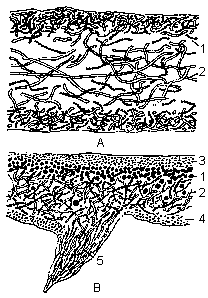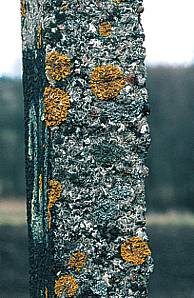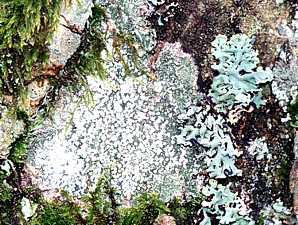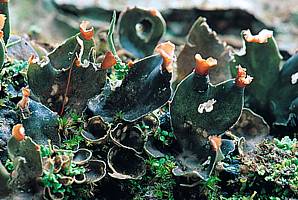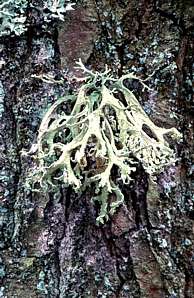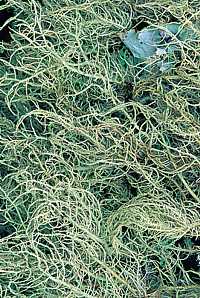|
LICHENS
|
|||||||||||||
Text:
|
General information
There are 20 thousand species of lichens in the world; 1600 of them growing in Poland. Despite their abundance in nature, this group is almost completely unknown to an average man.
Lichens are small organisms whose thallus varies from several millimeters up to several centimeters and only some species (e.g. Usnea hirta and Bryoria fuscescens) can reach up to 30 cm (the biggest lichen in Poland was Usnea longissima growing at the end of 70's of the 20th c. whose thallus grew to 2 meters of length). There are also organisms of great variability and due to this fact they are hard to mark and classify. The thallus may exist in the form of shell, bush, leaf or as a spectrum of the aforementioned. The color differentiation of their thallus is enormous: from white, grayness, yellow, orange, brown, green and blue up to black. Lichen are long-lived organisms. They live 50-100 years; sometimes even considerably longer - the age of lichen's thallus from Lapland is said to be 9 thousand years!
Not a long time ago the lichens were considered to be symbiotic thallus organisms classified to the kingdom of plants. According to the present taxonomy lichen are lichen-like fungi whose thallus contains, except for the typical cells of fungi, the cells of algae from the group of Chlorophyceae (green algae) and Cyanophyta (blue-green algae, cyanobacteria). Both fungi as well as algae are thallus organisms that is they do not produce organ such as roots, stems, leaves or typical tissues. Combined with the cells of algae the scraps of fungi can form more or less anatomic and physiologic complex.
The cells of fungus and of algae can be placed almost (not bedded thallus) regularly and evenly or they can form distinct layers (with outer and lower cortex). Both components are always dependent on each other. The relationship of fungus and algae are an example of symbiosis - fungus assures the place of existence and delivers water with mineral salts for algae while algae deliver the carbohydrates produced in the process of photosynthesis. Such a relationship is not always profitable for both sides and sometimes it becomes a slavery or a parasitism.
Lichens grow in almost all habitats occupying the poorest substrates such as: rocky or stony surface, the bark of trees, the sterile impoverished soil. They even grow on the stones which are completely or partly dipped in the water. Based on the type of basis they grow on they can be divided into the lichen growing on the rocky basis, the lichen growing on the trees and the lichen growing on the ground.
Based on the structure and shape of the thallus we can distinguish three morphological forms: shell-like lichens, leafy lichens and bushy lichens.
The bottom side of the shell-like cortex is compactly attached to the basis or becomes rooted in it creating different colors of shells or spots sometimes as if resembling a dirty coating. The surface of the cortex can be smooth, cracked, powder-like or seed-like. Porpidia crustulata, foraminifer bitter Petrusaria amara and Lecanora pulicaris are the examples of the shell-like lichens.
The leafy thallus is clearly flattened on the chest and on the back in shape of a leaflet. It consists of one or several petals attached to the basis with the help of the folds of the bottom side of the cortex or with the captors. The representatives of the leafy lichens are: Peltigera didactyla, Xanthoria candelaria and Vulpicida pinastri.
The bushy thallus is made from the twigs of different shapes: thread-like, cylindrical, belt-like and these twigs are usually attached to the basis in one point only. The twigs can be raised up just like at Cladonia fimbriata, they can hang loosely just like Evernia prunastri or they can trail on the basis just like Anaptychia ciliaris.
Due to the fact that lichens are extremely sensitive to the environmental changes, especially the pollution of atmospherical air, many species of lichen are in danger of extinction. There are a few reasons for this type of sensitivity:
In spite of the considerable improvements in the condition of our environments the rate of lichens disappearance is still very high. The main factors contributing to the state of things are different kinds of pollution (industrial, communal, communication) still emitted to the atmosphere, using much chemistry in the agriculture, cutting out the forests, especially the single old trees, lowering the atmospherical air and soil moisture, the exploitation of calcareous deposits and erratic stones. To pay attention to the danger of lichens extinction people proposed the "The red list of lichen which are in danger of extinction in Poland". This list includes 602 species of lichens, which constitutes over 37% of all species of lichens to be found in Poland. 60 species of lichens from this list are considered to have been extinct or lost (including 22 species of beard lichens), 180 species of lichens are thought to be dying out, 120 are subject to extinction, 127 are considered to be rare and 115 species are said to be in the undefined threat. Being on the list does not mean the legal protection. Such protection is guaranteed only by the suitable order of the Minister of the Environment. By the act of 11 September, 2001 the strict protection includes 239 species of lichens growing in Poland; just one sort is partially protected. One should remember that best way to protect the lichens is the protection of places of their occurrence.
The lichens growing in Wigry National Park are well classified and recognized.
|
||||||||||||
|
|
|
